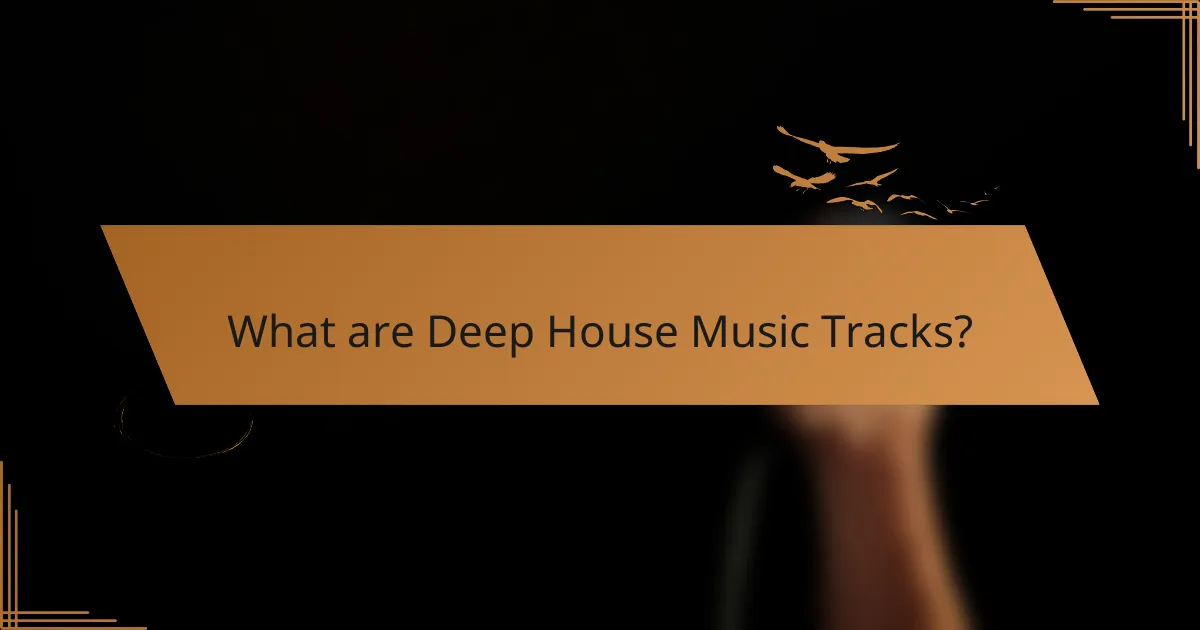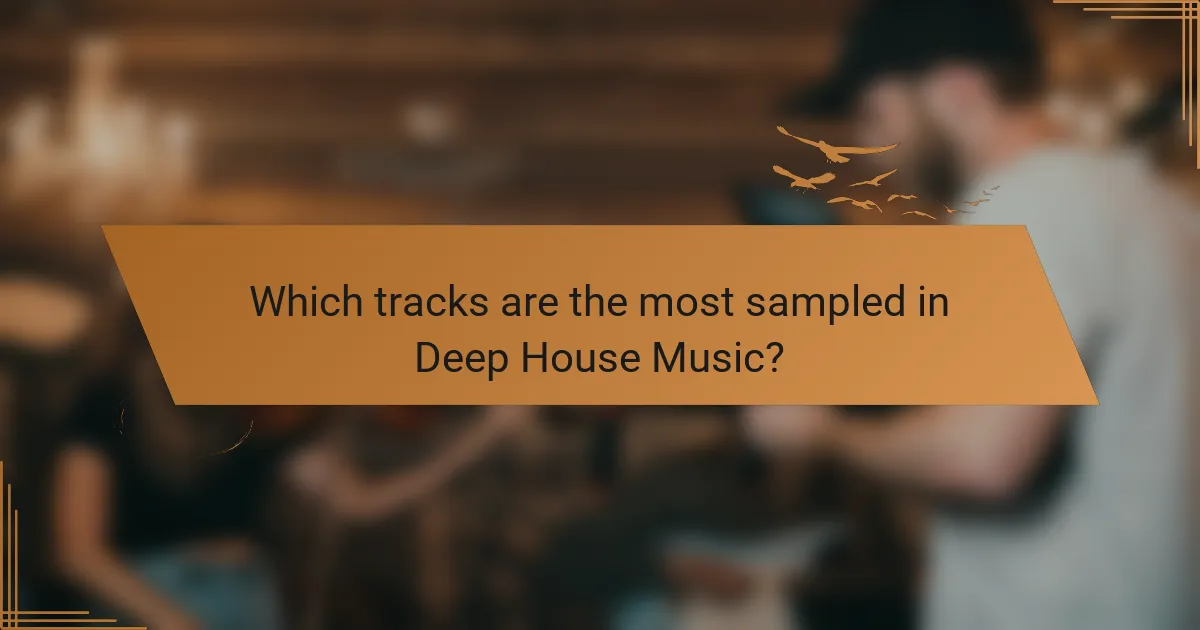Deep house music tracks represent a subgenre of house music known for their smooth, mellow sound, deeper basslines, and incorporation of jazz, soul, and funk elements. This article analyzes the most sampled tracks within deep house, highlighting notable examples such as “I Feel for You” by Bob Sinclar and “Can You Feel It” by Mr. Fingers, which have significantly influenced the genre’s development. The discussion includes the tempo, rhythm, and melodic structure that define deep house, as well as the impact of disco samples on contemporary tracks. Additionally, the article explores the trends in production techniques and the cultural shifts reflected in the evolving sound of deep house music.

What are Deep House Music Tracks?
Deep house music tracks are a subgenre of house music characterized by their smooth, mellow sound and deeper basslines. They typically feature complex melodies and harmonies, often incorporating elements of jazz, soul, and funk. The tempo of deep house tracks usually ranges from 120 to 125 beats per minute. Vocals in these tracks can be soulful and emotive, adding to the overall atmosphere. Deep house emerged in the 1980s and gained prominence in the 1990s with artists like Larry Heard and Kerri Chandler. Tracks often utilize synthesizers, drum machines, and samples from various music genres. These characteristics contribute to the distinctive vibe that deep house music is known for.
How did Deep House Music originate?
Deep House Music originated in the 1980s. It emerged from Chicago house music, incorporating elements of jazz, soul, and funk. Pioneers like Larry Heard and Frankie Knuckles played significant roles in its development. The genre is characterized by its smooth, melodic sound and slower tempo. Deep house often features complex chord progressions and soulful vocals. The genre gained popularity in clubs and underground scenes. By the 1990s, it had spread to Europe, influencing the global music landscape. The blend of electronic beats with rich instrumentation defines deep house’s unique appeal.
What influences shaped the evolution of Deep House Music?
Deep House Music evolved through various influences including jazz, soul, and funk. These genres contributed smooth melodies and complex rhythms. The Chicago house scene of the 1980s played a pivotal role in its development. Pioneers like Larry Heard incorporated deep basslines and atmospheric sounds. Additionally, the use of synthesizers and drum machines shaped its unique sound. The genre also embraced elements of disco, enhancing its danceability. Over time, global influences introduced diverse styles, further enriching deep house music. The fusion of these elements created the distinct sound recognized today.
What are the defining characteristics of Deep House Music?
Deep House Music is characterized by its smooth, soulful sound and deep basslines. The genre typically features slower tempos, usually between 120 to 125 beats per minute. It often incorporates elements of jazz, funk, and soul, creating a rich musical texture. Vocals in Deep House are usually soft and melodic, enhancing the emotional depth of the tracks. The use of complex chord progressions is common, contributing to its atmospheric quality. Additionally, Deep House often includes ambient sounds and effects, which create a relaxing vibe. The genre emerged in the 1980s and has roots in Chicago house music. Its defining characteristics have made it popular in club scenes and among DJs worldwide.
What role do samples play in Deep House Music?
Samples are fundamental in Deep House Music as they create unique soundscapes and enhance musical depth. They often incorporate elements from various genres, such as jazz, funk, and soul. This blending of sounds contributes to the genre’s signature groove and emotional resonance. Samples can include vocal snippets, instrumentals, or rhythmic patterns. The use of samples allows producers to pay homage to earlier music while adding contemporary flair. Notably, tracks like “Can You Feel It” by Mr. Fingers showcase how samples define the genre’s identity. Additionally, sampling can evoke nostalgia, connecting listeners to familiar sounds. Overall, samples play a crucial role in shaping the aesthetic and cultural context of Deep House Music.
Why are samples important in creating Deep House tracks?
Samples are important in creating Deep House tracks because they provide unique sounds and textures. These elements enhance the track’s overall atmosphere. Samples can include vocal snippets, instrumental loops, and sound effects. They contribute to the genre’s characteristic groove and depth. Additionally, samples can evoke emotions, making the music more relatable. Many successful Deep House tracks incorporate samples from various genres. This practice adds a layer of creativity and originality. For instance, renowned artists often use samples from classic soul or jazz records. This connection to past music enriches the listening experience.
How do producers choose samples for their Deep House tracks?
Producers choose samples for their Deep House tracks based on mood, genre characteristics, and originality. They often select samples that evoke a specific emotional response, aligning with the deep, soulful nature of the genre. Additionally, producers consider the rhythmic and melodic elements of samples to ensure compatibility with typical Deep House beats. Originality is crucial; producers aim to find unique sounds that differentiate their tracks from others. Many producers utilize sample packs or online libraries, which provide a diverse range of sounds tailored for Deep House. The use of samples from various genres, such as jazz or funk, is common to enhance the depth and complexity of the track. Ultimately, the choice of samples is a blend of personal style and the desire to create a distinct sonic experience.

Which tracks are the most sampled in Deep House Music?
“Deep House Music” features several highly sampled tracks. Notable examples include “I Feel for You” by Bob Sinclar. This track has been extensively used in various remixes and productions. Another frequently sampled track is “Can You Feel It” by Mr. Fingers. Its iconic synth lines have influenced many deep house artists. “Your Love” by Frankie Knuckles is also a significant sample in the genre. These tracks have shaped the sound of deep house music over the years. Their influence is evident in countless contemporary deep house tracks.
What are some of the most iconic sampled tracks in Deep House?
Some of the most iconic sampled tracks in Deep House include “Can You Feel It” by Mr. Fingers. This track features a distinctive piano riff that has been widely sampled. Another notable example is “I Feel for You” by Bob Sinclar, which incorporates a classic disco sample. “Finally” by Kings of Tomorrow is also significant, as it samples a well-known vocal line. Additionally, “Deep Inside” by Hardrive is famous for its powerful vocal sample. These tracks have shaped the Deep House genre and influenced many artists.
How have these tracks influenced the genre?
These tracks have significantly influenced the deep house genre by shaping its sound and production techniques. They introduced unique sampling methods that have become foundational in deep house music. The incorporation of soulful vocals and intricate melodies set a standard for emotional depth in the genre. Their rhythmic patterns influenced subsequent tracks, creating a recognizable groove that characterizes deep house. Notably, tracks like “Can You Feel It” by Mr. Fingers established a template for layering and texture. This has encouraged producers to experiment with new sounds and styles. The influence of these tracks is evident in the evolution of deep house, as they paved the way for modern interpretations. Their impact continues to resonate in contemporary deep house productions, affirming their lasting legacy.
What makes these tracks stand out in the Deep House scene?
These tracks stand out in the Deep House scene due to their unique blend of soulful melodies and rhythmic basslines. The incorporation of vocal samples adds emotional depth, making them more relatable. Additionally, innovative production techniques enhance their overall sound quality. Many of these tracks feature intricate layering, creating a rich auditory experience. Their ability to evoke strong feelings sets them apart from typical electronic music. Notably, tracks like “Can’t Get Enough” by Soulsearcher exemplify this blend, achieving significant chart success. The use of classic disco elements also resonates with listeners, bridging past and present influences. Overall, these characteristics contribute to their distinctiveness in the Deep House genre.
How do sampling techniques differ among Deep House producers?
Sampling techniques among Deep House producers vary significantly. Some producers utilize original samples from jazz or soul records. Others may opt for field recordings or sound design elements. The choice of samples often reflects individual artistic vision. Many producers focus on atmospheric textures, while others emphasize rhythmic elements. The selection process is influenced by genre trends and personal style. Furthermore, layering techniques can differ; some may use multiple samples for depth. Others prioritize a single, impactful sample for clarity. These differences shape the overall sound and feel of the tracks produced.
What are the common sampling methods used in Deep House Music?
Common sampling methods used in Deep House Music include loop sampling, one-shot sampling, and vocal sampling. Loop sampling involves taking a repeated segment from existing tracks to create a rhythmic foundation. One-shot sampling captures short, individual sounds or notes for use in beats and melodies. Vocal sampling integrates snippets of vocal performances to add texture and emotional depth. These methods enhance the genre’s characteristic sound and allow for creative reinterpretation. The use of these sampling techniques is prevalent in many iconic Deep House tracks, showcasing their importance in production.
How do these methods impact the overall sound of the tracks?
The methods used in deep house music significantly impact the overall sound of the tracks. Techniques such as sampling, layering, and effects processing create rich textures and complex soundscapes. Sampling allows producers to incorporate diverse sounds and influences, enhancing the track’s depth. Layering combines multiple musical elements, resulting in a fuller sound. Effects processing, including reverb and delay, adds spatial dimensions that enrich the listening experience. According to a study by the University of Southern California, tracks that utilize these methods can achieve a more immersive quality, making them more engaging for listeners. These methods collectively shape the unique characteristics of deep house music, influencing its emotional and sonic appeal.

What can we learn from analyzing sampled Deep House tracks?
Analyzing sampled Deep House tracks reveals the evolution of musical styles and influences. It highlights the common elements that define the genre. These elements include tempo, rhythm, and melodic structure. Furthermore, it showcases the use of samples from various genres, such as funk and soul. This blending creates a rich tapestry of sound.
Statistical analysis of popular tracks shows recurring sample sources. For example, tracks sampled from disco music often dominate charts. This indicates a strong connection between Deep House and its musical predecessors. Additionally, analyzing these samples can uncover trends in production techniques. Producers often utilize specific effects and arrangements that contribute to the Deep House sound.
Overall, the analysis provides insights into creativity and innovation within the genre. It also reflects cultural shifts and the ongoing dialogue between past and present music styles.
How can producers effectively use samples in their own tracks?
Producers can effectively use samples in their tracks by selecting high-quality sounds that complement their musical style. They should consider the genre and mood of their track when choosing samples. Layering samples can create depth and richness in the sound. Time-stretching samples can help them fit the tempo of the track without losing quality. Additionally, applying effects like reverb or delay can enhance the samples’ presence in the mix. Producers should also ensure they have the legal rights to use the samples to avoid copyright issues. Using samples creatively, such as chopping and rearranging, can result in unique sounds that stand out. Lastly, referencing successful tracks in the same genre can provide inspiration and guidance on sample usage.
What best practices should be followed when sampling?
When sampling in deep house music, it is essential to ensure originality and legal compliance. First, obtain proper clearance for any samples used. This prevents copyright infringement issues. Next, choose samples that enhance the track’s vibe and fit well with the overall sound. Using high-quality samples is crucial for maintaining audio fidelity. Additionally, consider manipulating the samples to create unique sounds. Techniques such as pitch shifting or time stretching can add originality. Lastly, document all samples and their sources. This practice aids in maintaining transparency and legality in music production.
What common mistakes should producers avoid when sampling?
Producers should avoid legal issues when sampling. Failing to clear samples can lead to copyright infringement. This mistake often results in legal disputes and financial penalties. Additionally, producers should not use low-quality samples. Poor audio quality can diminish the overall track. Another mistake is overusing samples. Excessive reliance on samples can stifle creativity. Also, producers should avoid using samples without understanding their context. Misinterpreting a sample’s original intent can lead to inappropriate usage. Lastly, neglecting to manipulate samples can make a track sound generic. Unique processing can help create a distinctive sound.
What are the future trends in sampling within Deep House Music?
Future trends in sampling within Deep House Music include the increased use of AI-generated samples. Artists are leveraging technology to create unique sounds that blend traditional elements with contemporary influences. Additionally, there is a growing trend towards incorporating organic sounds and field recordings. This approach adds depth and authenticity to tracks. Collaborations with artists from diverse genres are also on the rise. This fusion creates innovative sampling techniques. Moreover, the focus on sustainability is influencing sampling choices. Producers are seeking samples that align with eco-friendly practices. These trends reflect the evolving landscape of Deep House Music.
How might technology influence sampling in Deep House?
Technology significantly influences sampling in Deep House by providing advanced tools for music production. Digital audio workstations (DAWs) allow artists to manipulate samples with precision. Software plugins enhance sound quality and offer unique effects. This accessibility encourages experimentation with various audio sources. Sampling can now include high-quality recordings from diverse genres. Furthermore, technology enables seamless integration of samples into tracks. The rise of online sample libraries broadens the range of available sounds. Overall, technology democratizes the sampling process in Deep House music.
What emerging artists are pushing the boundaries of sampling in Deep House?
Emerging artists pushing the boundaries of sampling in Deep House include DJ Seinfeld, Ross From Friends, and Mall Grab. DJ Seinfeld utilizes lo-fi samples to create unique textures in his tracks. Ross From Friends blends nostalgic samples with modern beats, enhancing emotional depth. Mall Grab incorporates unconventional samples from various genres, adding diversity to his sound. These artists are redefining sampling techniques in Deep House, showcasing innovation and creativity. Their work has gained significant attention in the electronic music scene, pushing the genre forward.
Deep House Music Tracks are a subgenre of house music known for their smooth sound, deep basslines, and incorporation of elements from jazz, soul, and funk. This article analyzes the origins of deep house, its defining characteristics, and the role of sampling in shaping its sound. It highlights iconic sampled tracks, explores sampling techniques used by producers, and discusses future trends in the genre. Key artists and their contributions to deep house music are also examined, providing insights into the genre’s evolution and cultural significance.
